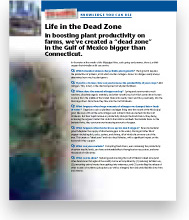CONTENTS
|
Organisms and their environments |
|
|
Ecosystems have living and non- |
|
|
15.1 |
What are ecosytems? 610 |
|
15.2 |
Biomes are large ecosystems that occur around the world, each determined by temperature and rainfall. 611 |
|
Interacting physical forces create weather. 614 |
|
|
15.3 |
Global air circulation patterns create deserts and rain forests. 614 |
|
15.4 |
Local topography influences the weather. 616 |
|
15.5 |
Ocean currents affect the weather. 618 |
|
Energy and chemicals flow within ecosystems 620 |
|
|
15.6 |
Energy flows from producers to consumers. 620 |
|
15.7 |
Energy pyramids reveal the inefficiency of food chains. 622 |
|
15.8 |
Essential chemicals cycle through ecosystems. 624 |
|
Species interactions influence the structure of communities. 628 |
|
|
15.9 |
Each species’ role in a community is defined as its niche. 628 |
|
15.10 |
Interacting species evolve together. 629 |
|
15.11 |
Competition can be hard to see, yet it influences community structure. 630 |
|
15.12 |
Predation produces adaptation in both predators and their prey. 631 |
|
15.13 |
Parasitism is a form of predation. 634 |
|
15.14 |
Not all species interactions are negative: mutualism and commensalism. 636 |
|
15.15 |
This is how we do it: Investigating ants, plants, and the unintended consequences of environmental intervention. 637 |
|
Communities can change or remain stable over time. 639 |
|
|
15.16 |
Many communities change over time. 639 |
|
15.17 |
Some species are more important than others within a community. 641 |
|
Life in the dead zone: in boosting plant productivity on farms, we’ve created a “dead zone” in the Gulf of Mexico bigger than Connecticut. 642 |
|
XIX
 15 • Ecosystems and Communities 609
15 • Ecosystems and Communities 609 StreetBIO: KNOWLEDGE YOU CAN USE
StreetBIO: KNOWLEDGE YOU CAN USE